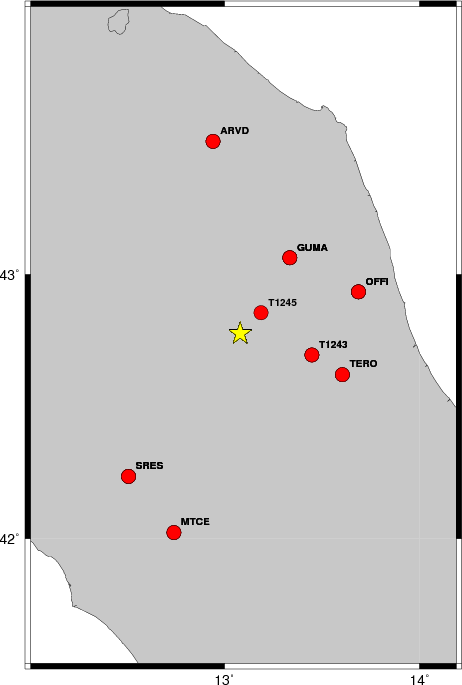
2016/11/02 06:07:48 42.7773 13.0812 10.4 3.4
SLU Moment Tensor Solution
ENS 2016/11/02 06:07:48:6 42.78 13.08 10.4 3.4
Stations used:
IV.ARVD IV.GUMA IV.MTCE IV.OFFI IV.SRES IV.T1243 IV.T1245
IV.TERO
Filtering commands used:
cut o DIST/3.3 -20 o DIST/3.3 +40
rtr
taper w 0.1
hp c 0.04 n 3
lp c 0.12 n 3
Best Fitting Double Couple
Mo = 6.68e+20 dyne-cm
Mw = 3.15
Z = 6 km
Plane Strike Dip Rake
NP1 324 85 -120
NP2 225 30 -10
Principal Axes:
Axis Value Plunge Azimuth
T 6.68e+20 33 78
N 0.00e+00 29 326
P -6.68e+20 42 205
Moment Tensor: (dyne-cm)
Component Value
Mxx -2.79e+20
Mxy -5.03e+19
Mxz 3.62e+20
Myy 3.79e+20
Myz 4.44e+20
Mzz -1.01e+20
--------------
----------------------
###---------##############--
#####----#####################
########-#########################
#######-----########################
#######-------########################
######-----------#######################
#####-------------############## #####
######---------------############ T ######
#####-----------------########### ######
####-------------------###################
####---------------------#################
###----------------------###############
###-----------------------##############
##---------- -----------############
##--------- P -------------#########
#--------- --------------#######
--------------------------####
--------------------------##
----------------------
--------------
Global CMT Convention Moment Tensor:
R T P
-1.01e+20 3.62e+20 -4.44e+20
3.62e+20 -2.79e+20 5.03e+19
-4.44e+20 5.03e+19 3.79e+20
Details of the solution is found at
http://www.eas.slu.edu/eqc/eqc_mt/MECH.IT/20161102060748/index.html
|
STK = 225
DIP = 30
RAKE = -10
MW = 3.15
HS = 6.0
The waveform inversion is preferred.
The following compares this source inversion to others
SLU Moment Tensor Solution
ENS 2016/11/02 06:07:48:6 42.78 13.08 10.4 3.4
Stations used:
IV.ARVD IV.GUMA IV.MTCE IV.OFFI IV.SRES IV.T1243 IV.T1245
IV.TERO
Filtering commands used:
cut o DIST/3.3 -20 o DIST/3.3 +40
rtr
taper w 0.1
hp c 0.04 n 3
lp c 0.12 n 3
Best Fitting Double Couple
Mo = 6.68e+20 dyne-cm
Mw = 3.15
Z = 6 km
Plane Strike Dip Rake
NP1 324 85 -120
NP2 225 30 -10
Principal Axes:
Axis Value Plunge Azimuth
T 6.68e+20 33 78
N 0.00e+00 29 326
P -6.68e+20 42 205
Moment Tensor: (dyne-cm)
Component Value
Mxx -2.79e+20
Mxy -5.03e+19
Mxz 3.62e+20
Myy 3.79e+20
Myz 4.44e+20
Mzz -1.01e+20
--------------
----------------------
###---------##############--
#####----#####################
########-#########################
#######-----########################
#######-------########################
######-----------#######################
#####-------------############## #####
######---------------############ T ######
#####-----------------########### ######
####-------------------###################
####---------------------#################
###----------------------###############
###-----------------------##############
##---------- -----------############
##--------- P -------------#########
#--------- --------------#######
--------------------------####
--------------------------##
----------------------
--------------
Global CMT Convention Moment Tensor:
R T P
-1.01e+20 3.62e+20 -4.44e+20
3.62e+20 -2.79e+20 5.03e+19
-4.44e+20 5.03e+19 3.79e+20
Details of the solution is found at
http://www.eas.slu.edu/eqc/eqc_mt/MECH.IT/20161102060748/index.html
|
The focal mechanism was determined using broadband seismic waveforms. The location of the event and the and stations used for the waveform inversion are shown in the next figure.

|
|
|
The program wvfgrd96 was used with good traces observed at short distance to determine the focal mechanism, depth and seismic moment. This technique requires a high quality signal and well determined velocity model for the Green functions. To the extent that these are the quality data, this type of mechanism should be preferred over the radiation pattern technique which requires the separate step of defining the pressure and tension quadrants and the correct strike.
The observed and predicted traces are filtered using the following gsac commands:
cut o DIST/3.3 -20 o DIST/3.3 +40 rtr taper w 0.1 hp c 0.04 n 3 lp c 0.12 n 3The results of this grid search from 0.5 to 19 km depth are as follow:
DEPTH STK DIP RAKE MW FIT
WVFGRD96 1.0 -5 40 -40 3.00 0.4568
WVFGRD96 2.0 215 20 -10 3.08 0.4621
WVFGRD96 3.0 220 25 -10 3.06 0.5775
WVFGRD96 4.0 225 30 -5 3.05 0.6374
WVFGRD96 5.0 225 25 -5 3.15 0.6662
WVFGRD96 6.0 225 30 -10 3.15 0.6786
WVFGRD96 7.0 225 30 -5 3.16 0.6780
WVFGRD96 8.0 230 35 0 3.14 0.6641
WVFGRD96 9.0 230 35 0 3.15 0.6435
WVFGRD96 10.0 225 35 -5 3.16 0.6188
WVFGRD96 11.0 235 35 10 3.16 0.5921
WVFGRD96 12.0 235 35 10 3.17 0.5656
WVFGRD96 13.0 240 35 15 3.18 0.5412
WVFGRD96 14.0 240 35 20 3.19 0.5189
WVFGRD96 15.0 240 30 20 3.22 0.4932
The best solution is
WVFGRD96 6.0 225 30 -10 3.15 0.6786
The mechanism correspond to the best fit is
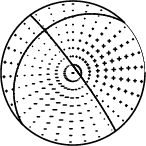
|
|
|
The best fit as a function of depth is given in the following figure:
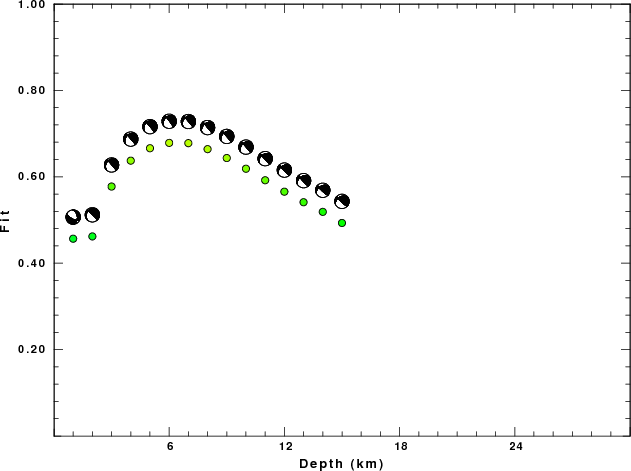
|
|
|
The comparison of the observed and predicted waveforms is given in the next figure. The red traces are the observed and the blue are the predicted. Each observed-predicted component is plotted to the same scale and peak amplitudes are indicated by the numbers to the left of each trace. A pair of numbers is given in black at the right of each predicted traces. The upper number it the time shift required for maximum correlation between the observed and predicted traces. This time shift is required because the synthetics are not computed at exactly the same distance as the observed and because the velocity model used in the predictions may not be perfect. A positive time shift indicates that the prediction is too fast and should be delayed to match the observed trace (shift to the right in this figure). A negative value indicates that the prediction is too slow. The lower number gives the percentage of variance reduction to characterize the individual goodness of fit (100% indicates a perfect fit).
The bandpass filter used in the processing and for the display was
cut o DIST/3.3 -20 o DIST/3.3 +40 rtr taper w 0.1 hp c 0.04 n 3 lp c 0.12 n 3
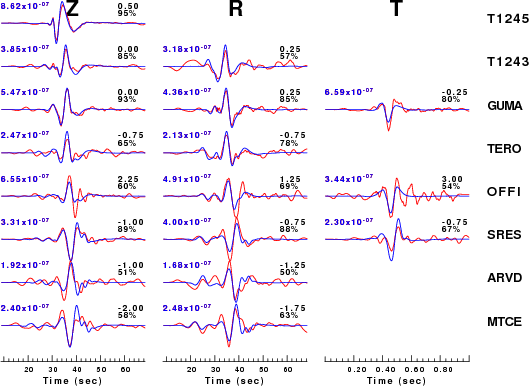
|
|
|
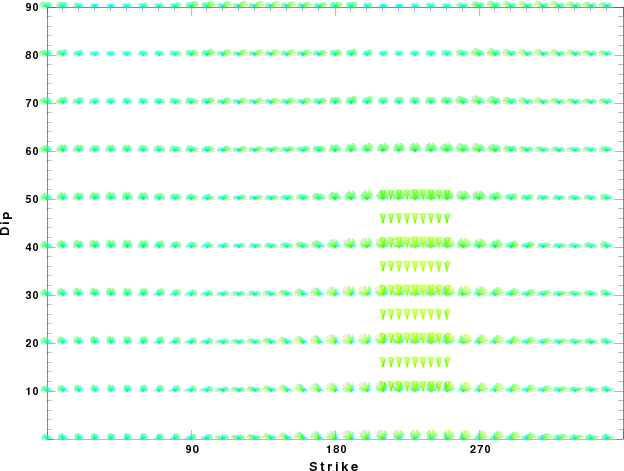
|
| Focal mechanism sensitivity at the preferred depth. The red color indicates a very good fit to thewavefroms. Each solution is plotted as a vector at a given value of strike and dip with the angle of the vector representing the rake angle, measured, with respect to the upward vertical (N) in the figure. |
A check on the assumed source location is possible by looking at the time shifts between the observed and predicted traces. The time shifts for waveform matching arise for several reasons:
Time_shift = A + B cos Azimuth + C Sin Azimuth
The time shifts for this inversion lead to the next figure:
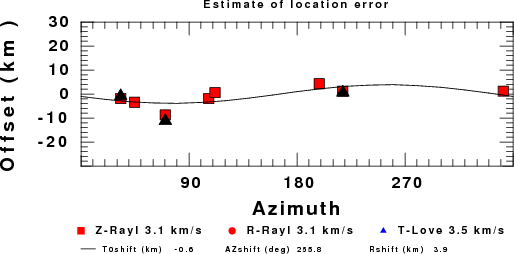
The derived shift in origin time and epicentral coordinates are given at the bottom of the figure.
The nnCIA used for the waveform synthetic seismograms and for the surface wave eigenfunctions and dispersion is as follows:
MODEL.01
C.It. A. Di Luzio et al Earth Plan Lettrs 280 (2009) 1-12 Fig 5. 7-8 MODEL/SURF3
ISOTROPIC
KGS
FLAT EARTH
1-D
CONSTANT VELOCITY
LINE08
LINE09
LINE10
LINE11
H(KM) VP(KM/S) VS(KM/S) RHO(GM/CC) QP QS ETAP ETAS FREFP FREFS
1.5000 3.7497 2.1436 2.2753 0.500E-02 0.100E-01 0.00 0.00 1.00 1.00
3.0000 4.9399 2.8210 2.4858 0.500E-02 0.100E-01 0.00 0.00 1.00 1.00
3.0000 6.0129 3.4336 2.7058 0.500E-02 0.100E-01 0.00 0.00 1.00 1.00
7.0000 5.5516 3.1475 2.6093 0.167E-02 0.333E-02 0.00 0.00 1.00 1.00
15.0000 5.8805 3.3583 2.6770 0.167E-02 0.333E-02 0.00 0.00 1.00 1.00
6.0000 7.1059 4.0081 3.0002 0.167E-02 0.333E-02 0.00 0.00 1.00 1.00
8.0000 7.1000 3.9864 3.0120 0.167E-02 0.333E-02 0.00 0.00 1.00 1.00
0.0000 7.9000 4.4036 3.2760 0.167E-02 0.333E-02 0.00 0.00 1.00 1.00
Here we tabulate the reasons for not using certain digital data sets
The following stations did not have a valid response files:
DATE=Thu Nov 3 08:35:48 CDT 2016